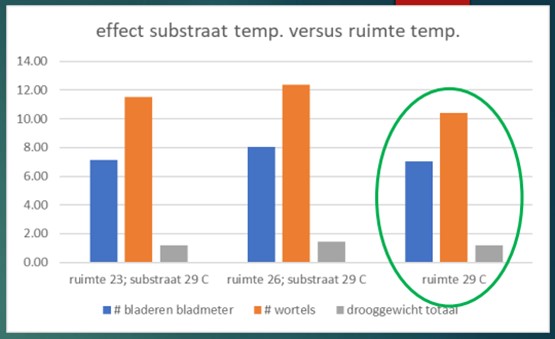If you look at the weather app on your phone, you will see that it gives more and more data besides the expected temperature and the current temperature. Sun up/down, wind force, wind direction, rainfall probability and amount, are some parts of the extra information. Wind chill is also one of them; how does the current temperature feel?
Determining this number is done by collecting a lot of data, reviewing, analysing and making connections between them. This way, one can determine this wind chill better and better. 10°C now has a wind chill of 4°C according to the app and tomorrow the same temperature will have a wind chill of 8°C. The difference is mainly in how much wind there is, whether there is any form of precipitation and what the relative humidity (RH) is. This does not include the amount of sunshine and whether or not the sun can be seen.

Wind chill (Image of pch.vector on Freepik)
Wind chill of a plant
What does the calculated wind chill in a weather app have to do with growing our crops, you might ask? More than you might expect. The data and trial results we showed at AnthuraNXT 2023 may fall under that. What is the wind chill of the prevailing greenhouse climate for the plant, how does the plant grow under those conditions and is that equivalent to the previous time at the same measured greenhouse climate? These are all questions that concern us. We discuss this with Marcel van Twist, Research Manager for Cultivation Research.

Marcel van Twist.
In several trials at Anthura and in external trials, we see that this is not always the case. With some regularity, we saw that with the same ‘created’ greenhouse climate, and the same measured values in the measurement box as the outcome, we could get a different growth or shape. An example of this is as follows: 150 umol of light at 20°C, 700 ppm CO2 and an RH of 70% can give different growth, crop shape or production in different trials, as well as in different growers. After analysis, it seems that the way the greenhouse climate was made was sometimes more explanatory of the results found than the measured greenhouse climate itself. Light, radiant heat, air movement, evaporation space, radiation, substrate humidity and a few more values had a lot of influence on the final results, making modulating growth – making a digital twin – a lot more difficult than expected. The question soon arose: can we also summarise these values into a kind of feel-good temperature for the plant and thereby better predict growth, shape and/or production?
This also immediately gave an explanation as to why comparing just measured values is not enough. You also need to look at how the climate was made, how the plant experienced this climate, what the light source was, for example, whether there was supportive air movement, etc.
An example
For example, 100 umol of light in January versus 100 umol of light in May gives a different growth, even though all other measured values are the same (temperature, CO2, RH). The energy content of the light in May is many times higher, which causes the plant and certainly the substrate to become warmer than in January. An entirely different microclimate is created, which the plant experiences differently and as a result the wind chill factor is higher in May than in January. Many a grower sometimes indicates; this climate does not feel good, despite the measuring box indicating that the values are the same. 20°C with sun also always feels warmer than 20°C without sun.
So the major influence of wind chill on plant growth made it difficult for us to develop a digital twin (growth model) in the past. Not only did we have to look at the measured values used to feed the model, but also how these values came about. Ee other factor that came into play was that not every breed responded the same to the changing climate. Some trials showed opposite results just by using other varieties in the trial, which in turn gave different results or results with a very wide margin (see diagram below).
The question arose “Can we calculate, or approximate, these values?” For this, long-term trials have been and continue to be conducted with varying genetics.”

Response to a change of only room temperature in phalaenopsis (Source: Anthura).
The switch from SON-T to LED also clearly showed this. Replacing a light source was not enough, as the plant temperature stayed behind. Adding the difference to equalise it was not enough. So is the difference between the room temperature and the plant temperature more important than just the room temperature? Is this smaller under LED? Is the non-heating of the substrate during the light period and its afterglow in the dark period perhaps the problem? We saw differences of sometimes 2°C between different light sources here, which could also explain part of the increased underground growth.

Effect of room and substrate temperature on growth, green circled is the control treatment.
Experiments conducted as a result of these measurements had the result that if we compensated for the missed temperature (substrate temperature) rather than the room temperature, we ended up much closer to summer growth (see also picture). This was new and good information for developing a growth model and perhaps a puzzle piece for calculating the wind chill.
All the results of our own and external trials regularly give us food for thought and make us realise that we still do not understand plant growth well enough. It teaches us that we should always look at results from several angles and that results from trials at other locations or with other varieties can give different results. Results that can be either positive or negative. When we replace something during cultivation, we need to look more often at what we are actually replacing all of it. Do you know what you are replacing when you hang a different type of light source, change your substrate mix or substitute variety x for variety y?
We are getting further and further along. Especially if we can convert the measured climate values into a wind chill for the plant or if we can decipher, calculate and/or rather measure them. Then we can more easily replace, change, compare things in cultivation and predict or explain the outcomes. Together with the expected or associated greenhouse climate, we will then be able to make a prediction for the coming period. Unfortunately, this will take some time, but we are on the right track.







